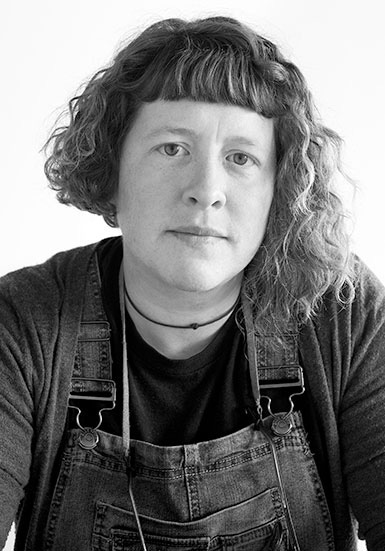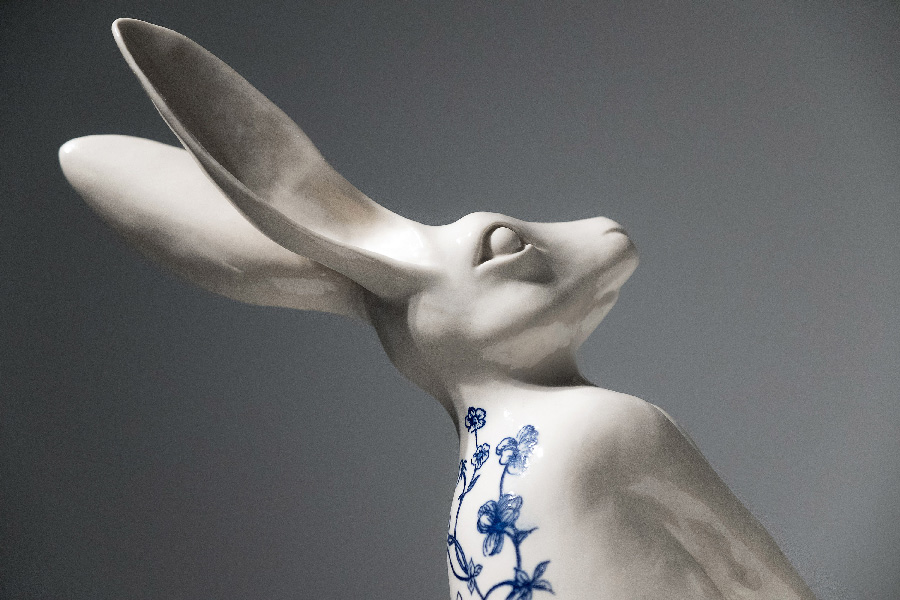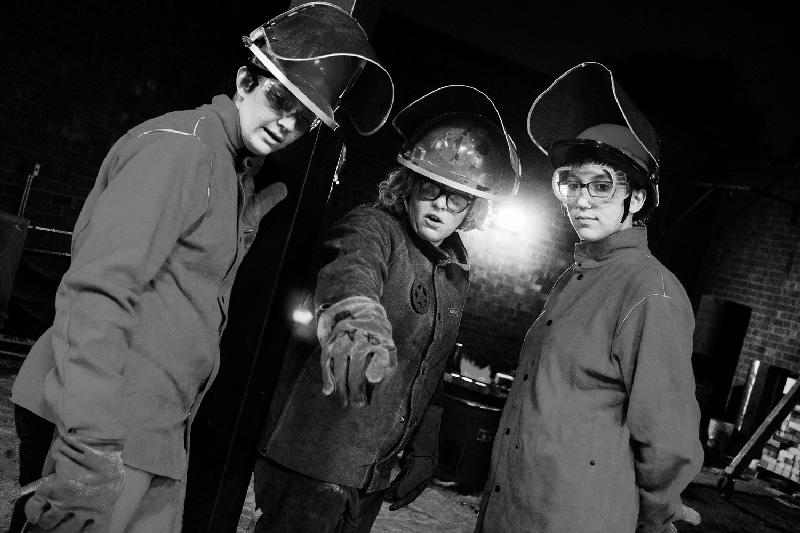This year, the University of Alabama at Birmingham will host the 2018 SECAC Conference, a national non-profit organization devoted to education and research in the visual arts. As part of the conference, AEIVA will host a solo exhibition for UAB Assistant Professor of Sculpture Stacey Holloway who is the recipient of SECAC’s annual Artist’s Fellowship.
AEIVA recently spoke with Holloway about her work and the upcoming exhibition, which opens Sept. 10 at AEIVA.
By Tina Ruggieri, AEIVA Intern
 AEIVA: How would you describe your work and your process?
AEIVA: How would you describe your work and your process?
Stacey Holloway: My work is very process-based and I like to work in a variety of materials. I don't stick to just one medium or process. I like to do a lot of metal casting, mold making, and wood working. I am more of a mixed media artist, which opens many possibilities. The conceptual ideas behind my work mostly come from my childhood memories. I thought I was going to be a vet. I grew up riding horses with my mom and volunteering at wildlife rehabilitation centers. We always had a ton of animals in and around the house. It was in grad school when I started symbolically using animals as to represent how we relate to one another as humans. We are all animals. When you see a sheep or a fawn, you think about vulnerability. When you see a lion, people might have different ideas behind its meaning. These animals may mean different things in different cultures. I also like to play around with ideas about aging and home.
AEIVA: Would you say your work is somewhat autobiographical as well?
Holloway: Yes. I am not originally from the South, I am from Northern Indiana, the Chicago area. I lived most of my life in the Midwest. I make work about how you never really feel like you are part of a group. My nephew is autistic, and I think he has trouble making friends. I see myself, and many others, dealing with the same issues he deals with. I think in certain ways that may be comforting for him and others like him, to know that everyone deals with these same issues.
AEIVA: Being a working artist, and a faculty member at UAB, how do you get involved in the community?
Holloway: I do a lot of community-based projects with my students. I believe it is extremely important to teach the students that being involved in the community can help their personal practice. We have worked with Sloss Metal Arts and with Ruffner Mountain Nature Preserve. Working on projects that involve the community shows students their work doesn't have to always be this single thing that lives in a gallery. Although artists often work alone, great ideas can also come from the community. However, they might not have the ability to execute their ideas. Working together, collaborating, can often make work stronger. We have done some work with Birmingham Water Works, creating water protector awards for them. We have also worked with the Birmingham Museum of Art. As I mentioned, I am a metal caster. The casting community, both locally and nationally, is a collaborative group and community-based. It is really one big family. For example, I worked with a professor locally and another professor from Massachusetts on a book project. We had many of the iron casting pioneers write letters to a fictitious young caster. We then put all of those into the book. The book is titled Warmest Regards: Letters to a Young Caster.
AEIVA: How do you inspire your students?
Holloway: Through social media, my students can see what I am doing with my personal practice on a daily basis. They see how busy I am, and how much hard work goes into my practice. I feel this inspires them, especially seeing me working so hard at my age. This helps them see what they can accomplish at their age with hard work. It makes me realize that I am not that young anymore. Also, whenever my students have ambitious ideas, instead of dismissing them right away, or saying, "I do not think we can do that", we say, let’s call Sloss Metal Arts and see if we can do it. We may also contact other universities, such as the University of Montevallo, to see if they can possibly help us. Once again, we work with the casting community, while making great connections, so that we won’t be limited on materials. The students get excited when they see their ideas realized, and the different ways we can go about it.

AEIVA: Can you briefly describe the SECAC Fellowship? Qualifications, process, results? And what it means for you to have won?
Holloway: I think this was the fourth or fifth year that I have applied for the SECAC Fellowship. SECAC asks you to propose a specific project that you would need additional funding on. It is also based off of merit. You must show that you can do what you say you are going to do. I feel that this fellowship is important because it is a peer award, and has also helped me in receiving my tenure. This funding will help me do something that I have been wanting to do for awhile. I want to create one large exhibition environment rather than separate pieces. The viewer will be immersed into the environment rather than looking from the outside. I am recreating a china shop filled with bees, birds, rabbits, and squirrels. I am investigating porcelain slip casting. The animals will be made to look like Blue Willow or Wedgwood china. There will be a giant bison in the center of this shop. He will be a bull in a china shop. I grew up with my parents saying stuff like, "Don't throw the baby out with the bath water” and other humorous sayings. One of the things they would say about me is that I was really clumsy, I was a “bull in a china shop.” I have also been investigating inner-species relationships that occur in nature. I think that it is really interesting when one animal joins a herd that they are not normally a part of, even a different species. Some people would see these animals as outsiders, but I actually see it as a way to make the herd stronger. Different animals carry different characteristics and when they combine the two you actually have a stronger sense of the group—the group can do something differently than what they could have done before without the outsider.
In doing research, I found that when they actually did put a bull in a china shop, the bull was quite aware of its space. An artist from New Orleans did a similar project. She brought a horse into an antique shop. She thought the horse would break the objects around it, but did not. The horse was aware of the space around it. So, the “bull in a china shop” idiom was actually proven wrong. The images that you see of the bull breaking the stuff in the china shop, that was because the bull was provoked. I used to make a lot of work about being an outsider and having a herd being very curious about the outsider and vise versa but now I am just trying to make work where that outsider is accepted into the herd.
AEIVA: Is SECAC a fellowship that helps artists with specific projects?
Holloway: Yes. It helps artists create a new body of work, or pursue something that they would not normally do. Even though I did slip-cast porcelain—very small things—in grad school, the larger porcelain project is new to me. I work mostly with metal and wood. These materials are structurally rigid. Up until it is fired, porcelain is very fragile. I have been the bull in the china shop. I am finding out ways that I can and cannot work with this new material.
I really enjoy working in a process-based way. In my metal casting, I will do a lot of different things. When I take a mold of something, I will pour it in wax and then I will manipulate the wax in some way. Then, I will pour metal, etc. With all of the new technologies used in making art today, I still enjoy feeling that the hand has been involved.
AEIVA: As an artist, why is it important to be involved in professional conferences?
 Holloway: You learn a lot. I’ve done SECAC almost every year that I have been here at UAB. This last summer I went to the Memphis Metal Museum for the Iron Invitational. I have been to Scranton, Pennsylvania for the International Conference on Contemporary Cast Iron Art. And I am on the steering committee for the National Conference on Contemporary Cast Iron Art and Practices, which happens here in Birmingham at Sloss Furnaces every other year. During these conferences you get to see a lot of exhibitions. There are also a lot of panels and presentations to attend that are very beneficial. You also meet a lot of people, and some of those people can help you in different ways. The conferences are important in making connections to those who are doing similar things, people you can bounce ideas off when you are trying to figure out a new method of working. During some of these conferences there are workshops, demos and classes that you can attend. You have to keep up with all the new techniques in order to stay knowledgeable for teaching. I never want to say to a student, "No, we can’t do that because I do not know how.” At the least, I will be able to say, "I know a person we can call because they do that.” Staying up to date with all of the different practices, especially in sculpture, is something that is very encompassing. There are also a lot of different materials that you can use. Staying up to date with materials and processes is something that helps you grow as an artist and helps you grow as a teacher.
Holloway: You learn a lot. I’ve done SECAC almost every year that I have been here at UAB. This last summer I went to the Memphis Metal Museum for the Iron Invitational. I have been to Scranton, Pennsylvania for the International Conference on Contemporary Cast Iron Art. And I am on the steering committee for the National Conference on Contemporary Cast Iron Art and Practices, which happens here in Birmingham at Sloss Furnaces every other year. During these conferences you get to see a lot of exhibitions. There are also a lot of panels and presentations to attend that are very beneficial. You also meet a lot of people, and some of those people can help you in different ways. The conferences are important in making connections to those who are doing similar things, people you can bounce ideas off when you are trying to figure out a new method of working. During some of these conferences there are workshops, demos and classes that you can attend. You have to keep up with all the new techniques in order to stay knowledgeable for teaching. I never want to say to a student, "No, we can’t do that because I do not know how.” At the least, I will be able to say, "I know a person we can call because they do that.” Staying up to date with all of the different practices, especially in sculpture, is something that is very encompassing. There are also a lot of different materials that you can use. Staying up to date with materials and processes is something that helps you grow as an artist and helps you grow as a teacher.
Don’t miss the 2018 SECAC Fellowship Exhibition — Stacey Holloway: Not to Be Otherwise, opening Sept. 10 at AEIVA.


